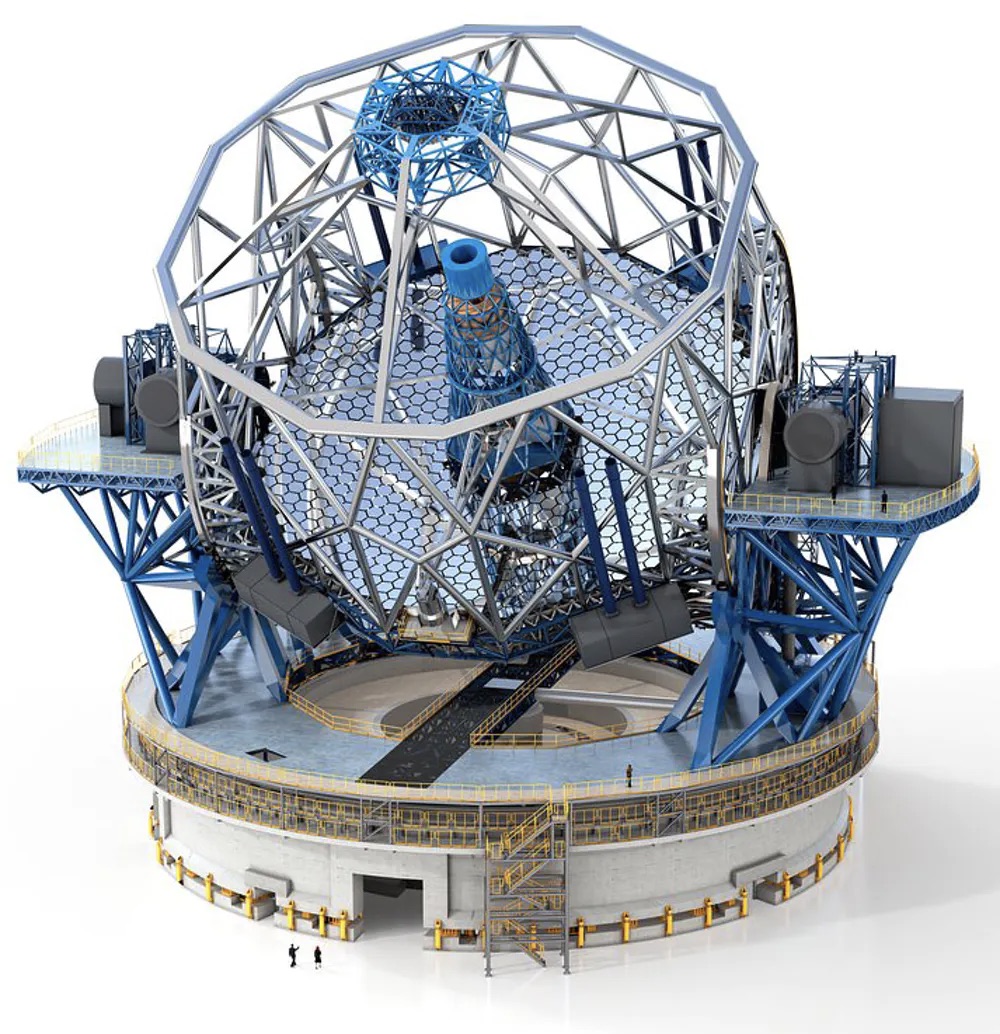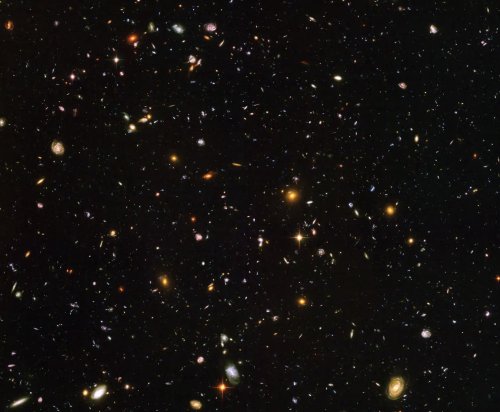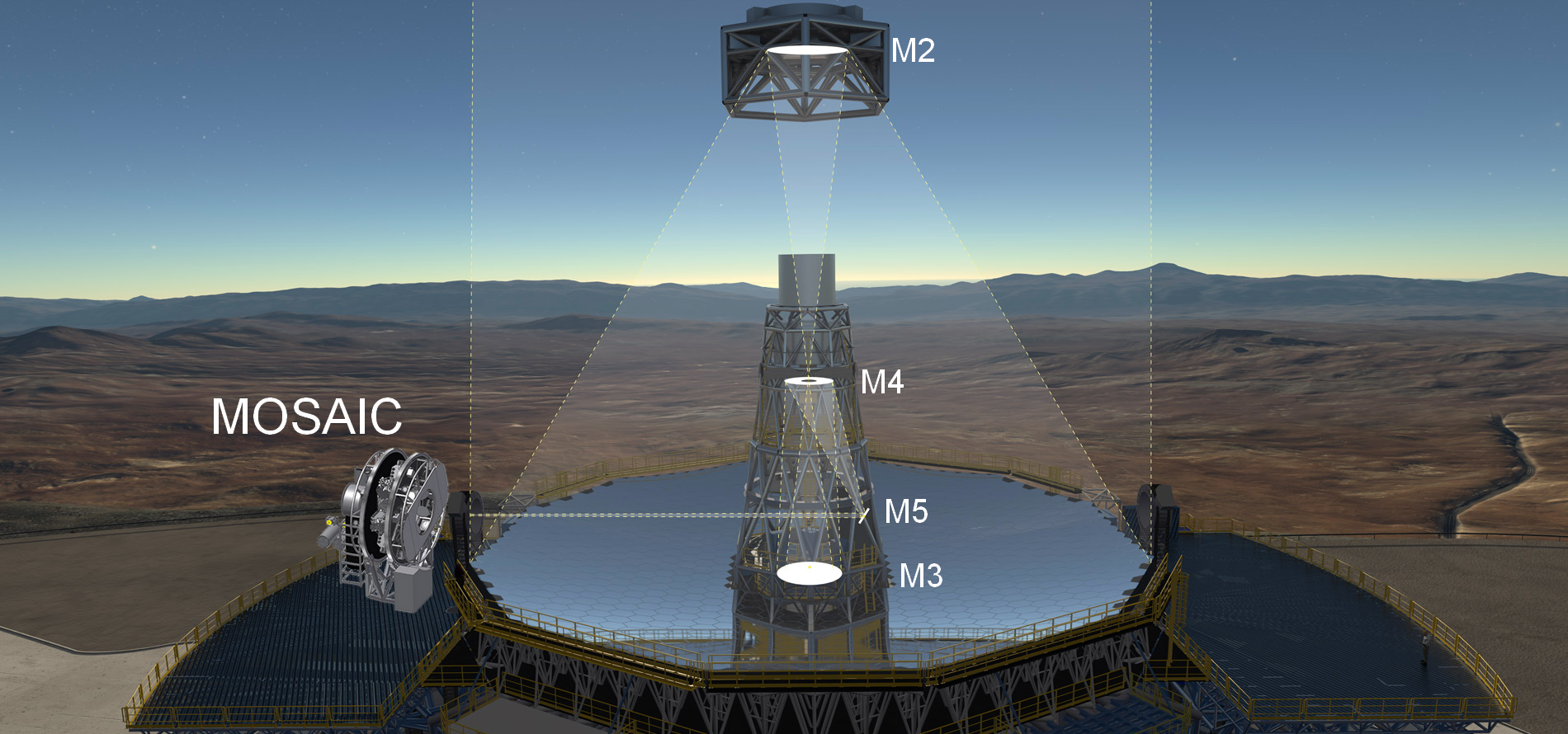The European organisation ESO has embarked on the construction of the Extremely Large Telescope (ELT) in the middle of the Chilean desert. The telescope and its structure reach a volume comparable to eight times that of the Arc de Triomphe in Paris.
A monster of technology
The collecting power of its ultra-giant mirror, 39 metres in diameter, is equivalent to bringing together the 16 largest telescopes in the world. When it is built, probably shortly after 2026, the ELT will be able to observe the weakest sources in the sky. It will be able to study objects so far away that they are inaccessible to other telescopes, unlocking many mysteries in cosmology, about the formation of galaxies, for example the nature of small galaxies or star clusters far beyond our Galaxy or Local Group.
Moreover, since the resolving power of a telescope depends on its size, the ELT will be able to solve the stars with the smallest apparent sizes: the apparent size of the most distant galaxies is much smaller than an arcsecond (for comparison, the Moon’s apparent size is 1800 arcseconds). At these scales, observations are very much affected by the Earth’s atmospheric turbulence, requiring advanced techniques to overcome it, such as adaptive optics.
 From the outset of the project, ESO has made a huge commitment to focus all its efforts on ensuring the highest possible spatial resolution. This is equivalent to counting the petals of a daisy 100 kilometres away! The goal is to distinguish an extrasolar planet from its star to distances approximately the thickness of a spiral arm of our Galaxy, in order to study in detail the planetary content of a considerable number of nearby and less nearby stars.
From the outset of the project, ESO has made a huge commitment to focus all its efforts on ensuring the highest possible spatial resolution. This is equivalent to counting the petals of a daisy 100 kilometres away! The goal is to distinguish an extrasolar planet from its star to distances approximately the thickness of a spiral arm of our Galaxy, in order to study in detail the planetary content of a considerable number of nearby and less nearby stars.
It’s a gamble that’s not insignificant since the main mirror will be made up of 798 segments, each 1.40 metres long, which will have to be aligned with an unequalled precision of only 15 millionths of a millimetre! The other four mirrors of the telescope will have to guarantee the same precision. In particular, two of these mirrors can be mechanically deformed to compensate for tiny variations in the path of light due to atmospheric turbulence. This is made possible by adaptive optics based on complex turbulence analysis systems.
Faced with the challenge of building a mastodon telescope capable of resolving the smallest sources of light in the universe, the European organisation ESO took an even riskier gamble: first install the most sophisticated instruments capable of obtaining the finest spatial resolutions, and only then the two instruments that use the telescope’s maximum collecting power instead (this being guaranteed, whatever the performance of the telescope and its enormous structure).
To observe the weakest and smallest sources in apparent size
 Thanks to its spatial resolution, the ELT will be able to distinguish the atmospheres of giant planets via spectroscopy, and allow a solid theory on the birth of planetary systems to be established. It will be able to directly observe the earliest sources of the universe, especially once it is equipped with a spectrograph that can observe a large number of objects at the same time. This will be a real revolution in cosmology, as it is believed that the first sources of the universe were born when the universe was only a few percent of its present age. These sources are so far away that today’s telescopes can observe only a tiny fraction of them. The ELT will help us understand how the present universe was formed - the difficulty is that the Universe was originally made up only of hydrogen and helium gases, which absorb most of the light rays. In other words, the Universe was opaque.
Thanks to its spatial resolution, the ELT will be able to distinguish the atmospheres of giant planets via spectroscopy, and allow a solid theory on the birth of planetary systems to be established. It will be able to directly observe the earliest sources of the universe, especially once it is equipped with a spectrograph that can observe a large number of objects at the same time. This will be a real revolution in cosmology, as it is believed that the first sources of the universe were born when the universe was only a few percent of its present age. These sources are so far away that today’s telescopes can observe only a tiny fraction of them. The ELT will help us understand how the present universe was formed - the difficulty is that the Universe was originally made up only of hydrogen and helium gases, which absorb most of the light rays. In other words, the Universe was opaque.
While participating in the development of sophisticated instruments aimed at high spatial resolution, France is responsible for the MOSAIC multi-object spectrograph that will make the most of the ELT’s collection power. In particular, it is thanks to MOSAIC that it will be possible to assess the quantity and evolution of dark matter - which could make up the majority of the mass of the universe, and to observe the first stars, star clusters or galaxies that allowed the universe to become transparent. The instrument will weigh nearly 35 tonnes, occupy a volume comparable to that of a 100 square metre apartment, and will include six spectrographs, the fibres and their positioners, as well as guidance systems and adaptive optics. If placed end to end, MOSAIC’s fibres could cover the distance Paris-Amsterdam. MOSAIC will be able to observe several hundred galaxies at a time, study their dynamics and chemical composition and thus their evolution.
 There are still many steps to go before the ELT deciphers the deepest mysteries of the universe. It must be ensured that the expected performance in spatial resolution can be met. The impact of the telescope and its gigantic dome on the conditions of atmospheric turbulence is questionable, as is the difficulty of achieving spatial resolutions that are inaccessible today. Will it be possible to hold the collecting surface performance? One problem is that the Earth’s atmosphere, in addition to its turbulence, emits a continuous light signal that is much more intense (up to several hundred times) than that from the weakest sources in the universe because it contains oxygen, nitrogen and water vapour emitting at visible and infrared wavelengths. Very precise techniques for "subtracting atmospheric emissions" (known as "sky subtraction") are being investigated.
There are still many steps to go before the ELT deciphers the deepest mysteries of the universe. It must be ensured that the expected performance in spatial resolution can be met. The impact of the telescope and its gigantic dome on the conditions of atmospheric turbulence is questionable, as is the difficulty of achieving spatial resolutions that are inaccessible today. Will it be possible to hold the collecting surface performance? One problem is that the Earth’s atmosphere, in addition to its turbulence, emits a continuous light signal that is much more intense (up to several hundred times) than that from the weakest sources in the universe because it contains oxygen, nitrogen and water vapour emitting at visible and infrared wavelengths. Very precise techniques for "subtracting atmospheric emissions" (known as "sky subtraction") are being investigated.
A difficult path for ultra-giant telescopes
There are now several plans to install ultra-giant telescopes around the world, including one in Europe, the ELT, and two in the United States, the Thirty Meters Telescope (scheduled for delivery in 2030 at the earliest) and the Giant Magellanic Telescope. The American projects are suffering from implementation difficulties or still very incomplete financing. But although less advanced, the American projects are being conducted pragmatically, first using collector power and then gradually implementing a series of high-tech instruments to guarantee fine spatial resolution.
The first hexagonal components of the primary mirror are cast by the Schott company in Mainz. Schott/ESO, CC BY
The ELT budget, of which a small fraction (10-15%) remains to be completed, does not allow the European organisation ESO to finance the French instrument MOSAIC. Beyond the technical complexities, the MOSAIC team has had to set up an original self-financing system, with the help of many scientific leaders in France, Europe, the United States and Brazil. The most important countries in the collaboration are the United Kingdom, Germany and the Netherlands, and of course France. The capabilities of the instrument attract many financial contributions that are gradually being put in place, e.g. from the Space Telescope Science Institute (which manages the space telescope), or from European, Finnish, Swiss, etc. bodies. The gradual establishment of the new astronomy mastodon, the Extremely Large Telescope and its series of instruments is one of the most exciting and promising adventures in modern astronomy.
The Ile-de-France Region funds research projects in Areas of Major Interest and is committed, through the Paris Region Phd scheme, to the development of PhD and training through research by co-financing 100 doctoral contracts by 2022. To find out more, visit iledefrance.fr/education-research.
Original article in french and in english on the Paris Observatory's website.



